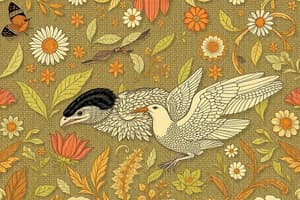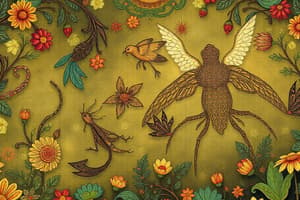Podcast
Questions and Answers
Which of the following is NOT one of the five main lines of evidence for evolution?
Which of the following is NOT one of the five main lines of evidence for evolution?
- Comparative anatomy
- Fossil record
- Natural selection (correct)
- Geographical distribution
Endemic species are organisms that can be found in multiple geographic locations.
Endemic species are organisms that can be found in multiple geographic locations.
False (B)
What type of structures demonstrate comparative anatomy and show evolutionary links between species?
What type of structures demonstrate comparative anatomy and show evolutionary links between species?
Vestigial structures, analogous structures, and homologous features.
The study of similarities during embryological development between different organisms is known as __________.
The study of similarities during embryological development between different organisms is known as __________.
Match each line of evidence for evolution with its correct description:
Match each line of evidence for evolution with its correct description:
What does the term 'fitness' refer to in the context of natural selection?
What does the term 'fitness' refer to in the context of natural selection?
Survival of the fittest means that the strongest organisms will always survive.
Survival of the fittest means that the strongest organisms will always survive.
Name one type of natural selection.
Name one type of natural selection.
_______ selection is when humans choose which traits are passed on to the next generation.
_______ selection is when humans choose which traits are passed on to the next generation.
Match the following types of selection with their definitions:
Match the following types of selection with their definitions:
Which type of evolution involves unrelated species evolving similar traits?
Which type of evolution involves unrelated species evolving similar traits?
Natural selection can lead to the adaptation of populations to their environments over time.
Natural selection can lead to the adaptation of populations to their environments over time.
What process describes the evolution of two or more related species adapting different traits?
What process describes the evolution of two or more related species adapting different traits?
The process by which two species influence each other's evolution is known as ________.
The process by which two species influence each other's evolution is known as ________.
Which of the following is NOT a type of sexual selection?
Which of the following is NOT a type of sexual selection?
Disruptive selection tends to favor individuals with traits that are average.
Disruptive selection tends to favor individuals with traits that are average.
What type of evolution involves a single ancestral species diversifying into multiple species?
What type of evolution involves a single ancestral species diversifying into multiple species?
Individuals within a species compete for __________ to survive.
Individuals within a species compete for __________ to survive.
What influences which traits are advantageous for survival in a population?
What influences which traits are advantageous for survival in a population?
What does the term 'immutable' refer to in the context of life on Earth?
What does the term 'immutable' refer to in the context of life on Earth?
Microevolution involves the evolution of entire species.
Microevolution involves the evolution of entire species.
What does LeClerc's Theory of Degenerative Forms emphasize about species?
What does LeClerc's Theory of Degenerative Forms emphasize about species?
Darwin’s four steps of natural selection include variations among species, inherited variations, and overproduction of _________.
Darwin’s four steps of natural selection include variations among species, inherited variations, and overproduction of _________.
Match the following concepts with their descriptions:
Match the following concepts with their descriptions:
Which of the following statements aligns with Jean Baptiste LaMarck's theory of evolution?
Which of the following statements aligns with Jean Baptiste LaMarck's theory of evolution?
George Cuvier’s belief in catastrophism suggests that evolution occurs gradually over time.
George Cuvier’s belief in catastrophism suggests that evolution occurs gradually over time.
What role does 'variation' play in Darwin's theory of natural selection?
What role does 'variation' play in Darwin's theory of natural selection?
Flashcards
Comparative Anatomy
Comparative Anatomy
The study of structural similarities and differences between organisms, often used to indicate evolutionary relationships.
Fossil Record
Fossil Record
Physical remains of ancient organisms preserved in sedimentary rock, providing evidence of past life and evolutionary changes.
Geographical Distribution
Geographical Distribution
The distribution of species across the globe, often influenced by geographic barriers and the movement of continents.
Embryology
Embryology
Signup and view all the flashcards
Biochemical Similarities
Biochemical Similarities
Signup and view all the flashcards
Immutability
Immutability
Signup and view all the flashcards
Microevolution
Microevolution
Signup and view all the flashcards
Macroevolution
Macroevolution
Signup and view all the flashcards
Vestigial Feature
Vestigial Feature
Signup and view all the flashcards
LeClerc's Theory of Degenerative Forms
LeClerc's Theory of Degenerative Forms
Signup and view all the flashcards
Catastrophism
Catastrophism
Signup and view all the flashcards
Uniformitarianism
Uniformitarianism
Signup and view all the flashcards
Natural Selection
Natural Selection
Signup and view all the flashcards
Fitness
Fitness
Signup and view all the flashcards
Variation and Inheritance
Variation and Inheritance
Signup and view all the flashcards
Competition and Survival
Competition and Survival
Signup and view all the flashcards
Selection Pressures
Selection Pressures
Signup and view all the flashcards
Artificial Selection
Artificial Selection
Signup and view all the flashcards
Ecological Selection
Ecological Selection
Signup and view all the flashcards
Sexual Selection
Sexual Selection
Signup and view all the flashcards
Intersexual Selection
Intersexual Selection
Signup and view all the flashcards
Intrasexual Selection
Intrasexual Selection
Signup and view all the flashcards
Directional Selection
Directional Selection
Signup and view all the flashcards
Disruptive Selection
Disruptive Selection
Signup and view all the flashcards
Sexual Dimorphism
Sexual Dimorphism
Signup and view all the flashcards
Divergent Evolution
Divergent Evolution
Signup and view all the flashcards
Adaptive Radiation
Adaptive Radiation
Signup and view all the flashcards
Study Notes
Evolution
- Evolution: Life on Earth adapts to changing environments.
Immutable vs. Changeable Life
- Immutable: The idea that life forms are unchanging, created in their current state.
- Changeable: Life forms can and do change over time in response to environmental pressures and processes.
Micro vs. Macroevolution
- Microevolution: Small-scale changes within a species, examples include faster rabbits and drug-resistant bacteria.
- Macroevolution: Larger-scale changes, including extinction and significant evolutionary divergence of organisms.
Eidos
- Eidos: The idealized, perfect form of a creature, as an idea of a plan from a higher source.
Vestigial Features
- Vestigial feature: A feature with no current purpose or function; an example is an appendix. These features provide evidence against immutable life forms.
LeClerc's Theory of Degenerative Forms
- LeClerc challenged the immutability of species by suggesting organisms could change in response to the environment.
Lamarck's Theory of Parallel Evolution
- Lamarck's theory: Each species evolved independently.
- Incorrect Lamarckian principle: Acquired traits during an organism's lifetime are not passed to offspring.
Cuvier and Lyell
- Cuvier (Catastrophism): Belief that catastrophic events created organisms
- Lyell (Uniformitarianism): Catastrophic events have always existed and shaped the Earth.
Natural Selection
- Natural selection: Organisms with beneficial traits are more likely to survive and reproduce.
Darwin's 4 Steps to Natural Selection
- Variations exist: Individual variations exist within a species (e.g., fast and slow rabbits)
- Inherited variations: Variations are passed from parents to offspring.
- More offspring than can survive: Populations produce more offspring than can survive due to resource limitations;
- Differential survival: Organisms with beneficial traits are more likely to survive and reproduce.
Survival of the Fittest
- Fitness: The ability of an organism to survive and reproduce successfully in its environment.
Evidence Against Darwin's Theory (and how it was countered)
- Earth's age: Not all scientists believed the Earth was old enough for evolution to occur
- Small variations to large changes: Some argued that small variations couldn't produce major new forms in organisms
- Mendel's work: Gregor Mendel's work on inheritance of traits supported Darwin's ideas.
Selection Pressures
- Selection pressures: Environmental factors favoring certain traits for survival and reproduction.
Types of Selection
- Natural selection: Favors traits beneficial for survival;
- Artificial selection: Humans select traits for desirable outcomes.
- Ecological Selection: Environmental factors (resources competition, etc.) drive selection.
- Sexual Selection: Traits that improve mating success.
- Intersexual Selection: One sex chooses mates in the other.
- Intrasexual Selection: Competition among members of the same sex for mates.
Patterns of Natural Selection
- Directional Selection: Favors one extreme of a trait.
- Disruptive Selection: Favors both extremes of a trait.
- Stabilizing Selection: Favors the average trait.
Sexual Dimorphism
- Sexual dimorphism: Physical differences between males and females of the same species.
Patterns of Evolution
- Convergent evolution: Unrelated species develop similar traits due to similar environments.
- Divergent evolution: Related species evolve different traits due to different environments.
- Adaptive radiation: A single species diversifies into many related species filling different niches.
- Coevolution: Two or more species evolve in response to each other.
Endemic Species
- Endemic species: Organisms found in only one particular geographic area.
Evidence for Evolution
- Comparative anatomy: Similarities in body structures indicate common ancestry.
- Fossil record: Fossil sequences reveal a progression of life forms over time.
- Geographical distribution: Locations of organisms reflect their evolutionary history.
- Embryology: Similarities in early development support common ancestry.
- Biochemical similarities: Similar DNA and proteins show common ancestry.
Studying That Suits You
Use AI to generate personalized quizzes and flashcards to suit your learning preferences.




